Apple Inc.: Global Supply Chain Network and Analysis Report
VerifiedAdded on 2019/09/25
|11
|2571
|196
Report
AI Summary
This report provides a comprehensive analysis of Apple Inc.'s international supply chain management. It delves into the company's global supply chain network, examining the trade-offs between cost and efficiency. The report explores the application of Porter's Diamond, Uppsala, and Dunning Eclectic Paradigm theories to evaluate Apple's supply chain strategies. It also highlights the key elements of Apple's global supply chain, including inventory, facilities, transportation, information sharing, procurement, and production. The report further analyzes the connectivity of these elements through the distribution network and offers recommendations for improving Apple's supply chain practices. The analysis includes how Apple uses its supply chain for competitive advantage through innovation, and how it can continue to improve by focusing on customer relationships and strategic planning for international challenges. The report concludes by emphasizing the importance of high-quality products and creative strategies in maintaining Apple's market leadership.
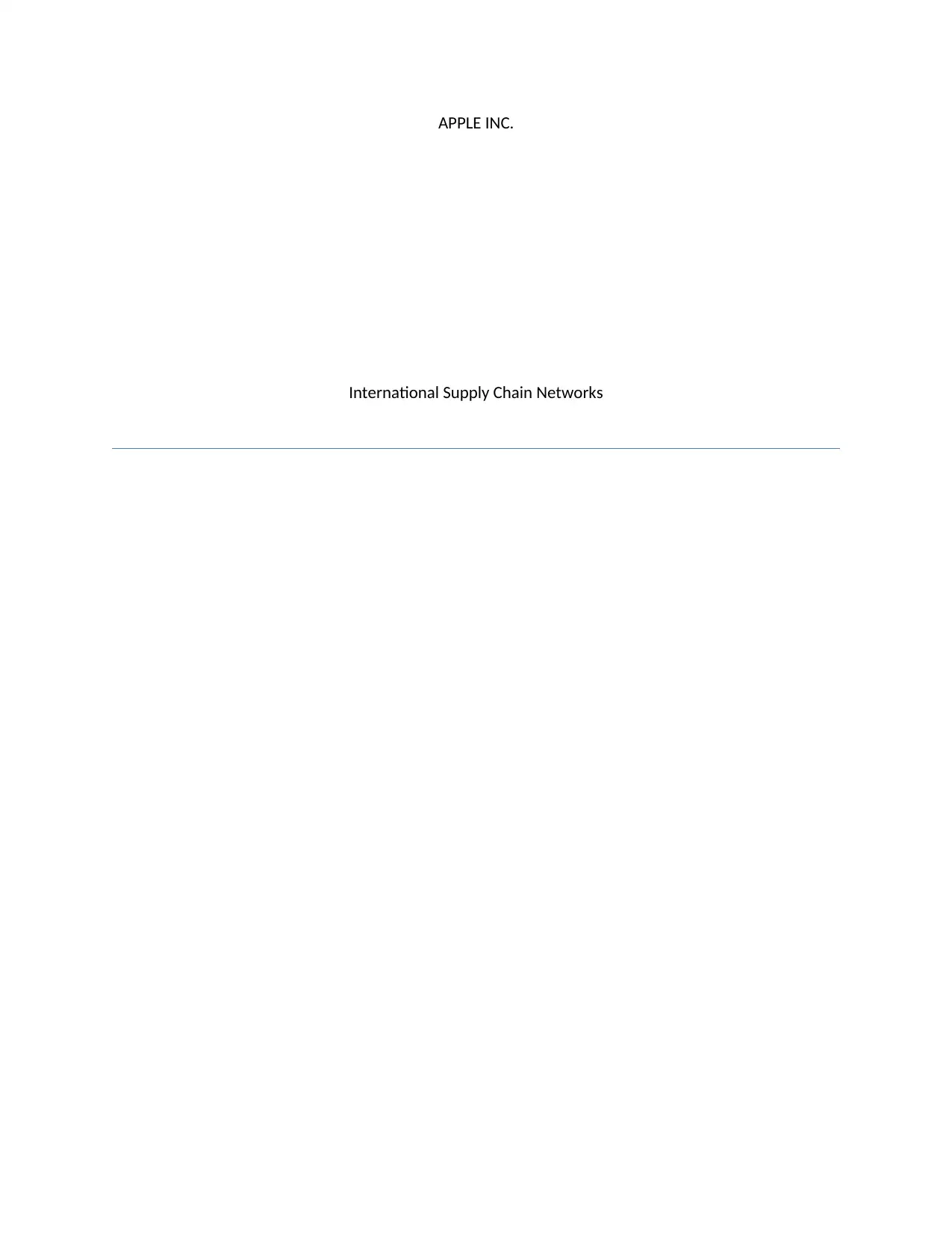
APPLE INC.
International Supply Chain Networks
International Supply Chain Networks
Paraphrase This Document
Need a fresh take? Get an instant paraphrase of this document with our AI Paraphraser
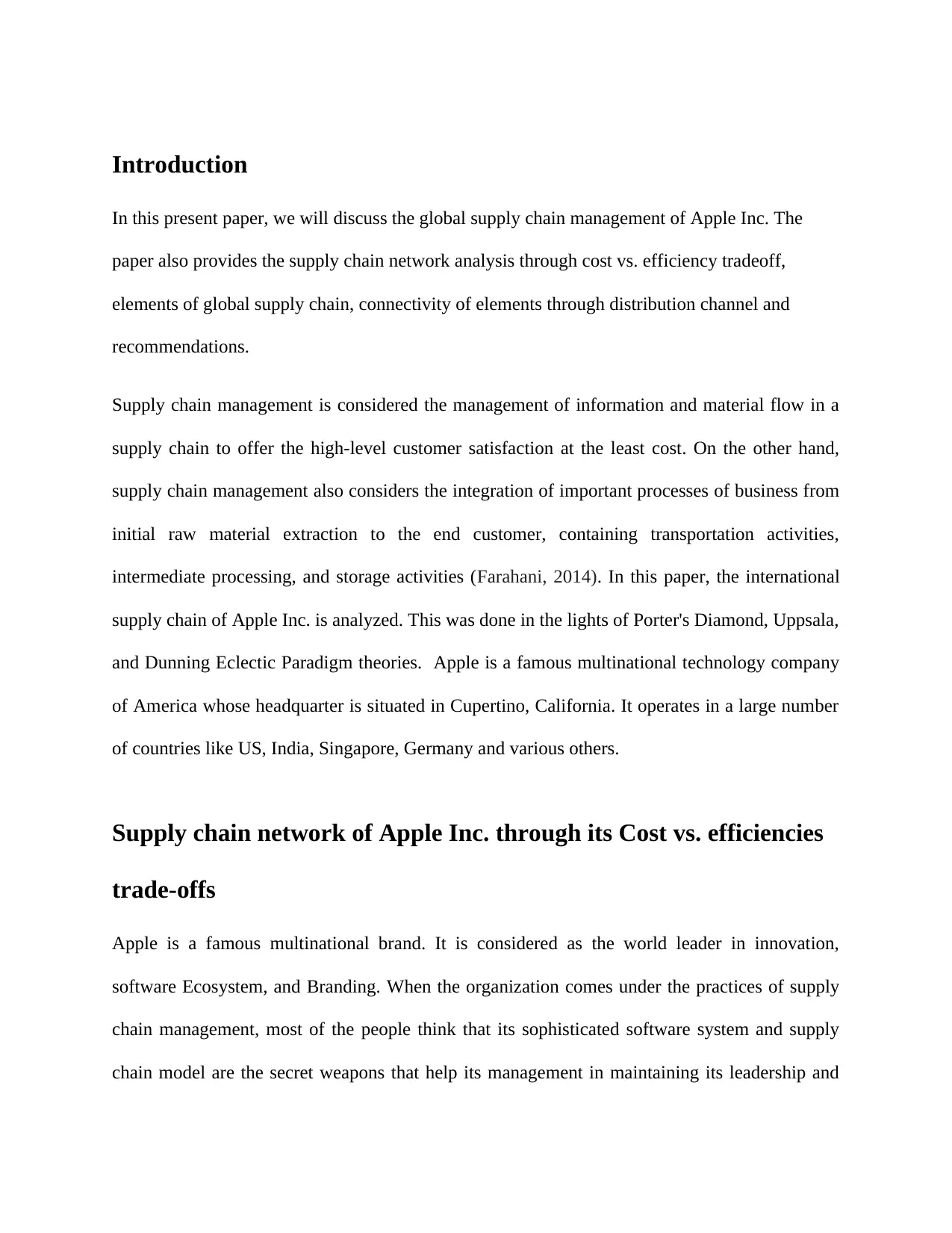
Introduction
In this present paper, we will discuss the global supply chain management of Apple Inc. The
paper also provides the supply chain network analysis through cost vs. efficiency tradeoff,
elements of global supply chain, connectivity of elements through distribution channel and
recommendations.
Supply chain management is considered the management of information and material flow in a
supply chain to offer the high-level customer satisfaction at the least cost. On the other hand,
supply chain management also considers the integration of important processes of business from
initial raw material extraction to the end customer, containing transportation activities,
intermediate processing, and storage activities (Farahani, 2014). In this paper, the international
supply chain of Apple Inc. is analyzed. This was done in the lights of Porter's Diamond, Uppsala,
and Dunning Eclectic Paradigm theories. Apple is a famous multinational technology company
of America whose headquarter is situated in Cupertino, California. It operates in a large number
of countries like US, India, Singapore, Germany and various others.
Supply chain network of Apple Inc. through its Cost vs. efficiencies
trade-offs
Apple is a famous multinational brand. It is considered as the world leader in innovation,
software Ecosystem, and Branding. When the organization comes under the practices of supply
chain management, most of the people think that its sophisticated software system and supply
chain model are the secret weapons that help its management in maintaining its leadership and
In this present paper, we will discuss the global supply chain management of Apple Inc. The
paper also provides the supply chain network analysis through cost vs. efficiency tradeoff,
elements of global supply chain, connectivity of elements through distribution channel and
recommendations.
Supply chain management is considered the management of information and material flow in a
supply chain to offer the high-level customer satisfaction at the least cost. On the other hand,
supply chain management also considers the integration of important processes of business from
initial raw material extraction to the end customer, containing transportation activities,
intermediate processing, and storage activities (Farahani, 2014). In this paper, the international
supply chain of Apple Inc. is analyzed. This was done in the lights of Porter's Diamond, Uppsala,
and Dunning Eclectic Paradigm theories. Apple is a famous multinational technology company
of America whose headquarter is situated in Cupertino, California. It operates in a large number
of countries like US, India, Singapore, Germany and various others.
Supply chain network of Apple Inc. through its Cost vs. efficiencies
trade-offs
Apple is a famous multinational brand. It is considered as the world leader in innovation,
software Ecosystem, and Branding. When the organization comes under the practices of supply
chain management, most of the people think that its sophisticated software system and supply
chain model are the secret weapons that help its management in maintaining its leadership and
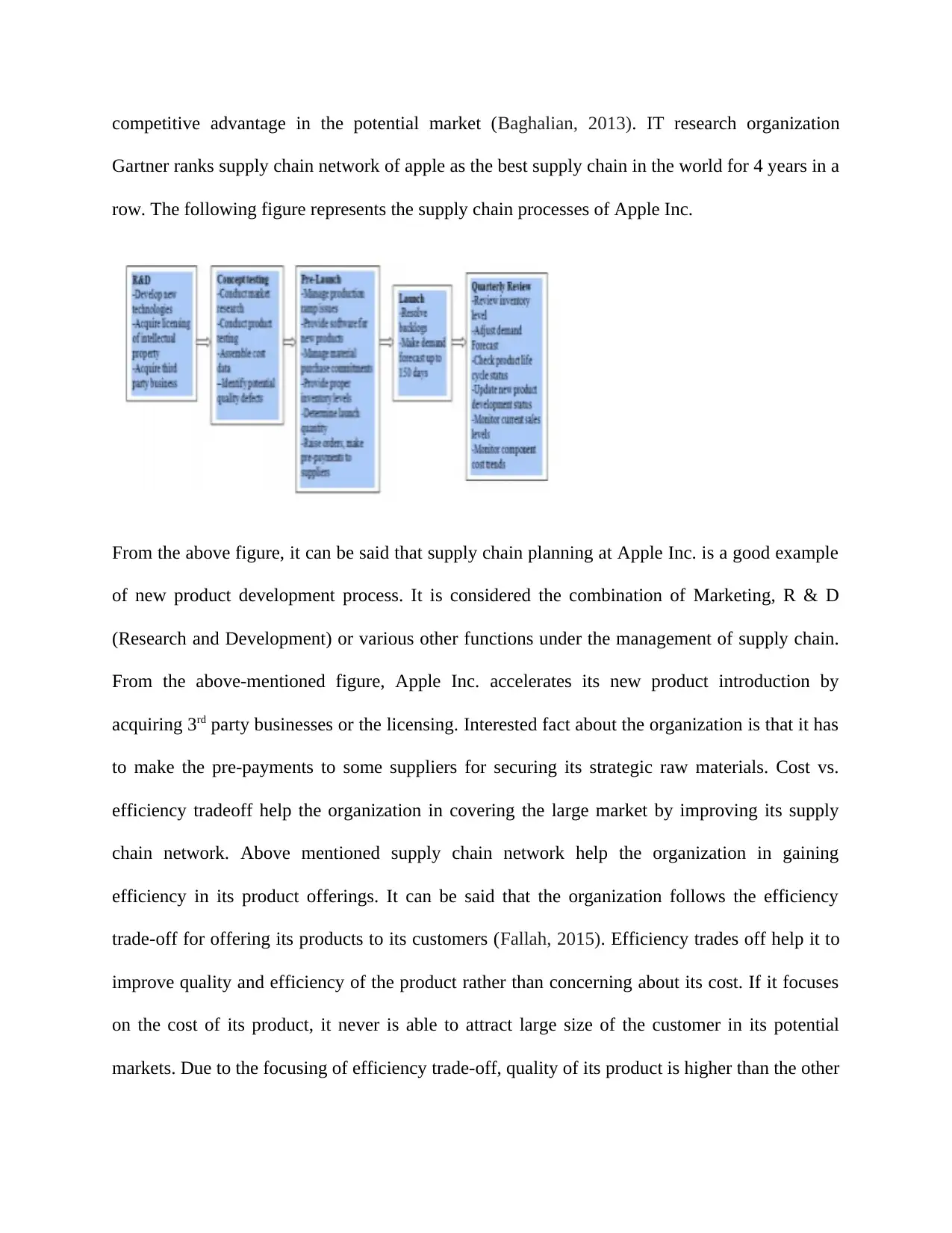
competitive advantage in the potential market (Baghalian, 2013). IT research organization
Gartner ranks supply chain network of apple as the best supply chain in the world for 4 years in a
row. The following figure represents the supply chain processes of Apple Inc.
From the above figure, it can be said that supply chain planning at Apple Inc. is a good example
of new product development process. It is considered the combination of Marketing, R & D
(Research and Development) or various other functions under the management of supply chain.
From the above-mentioned figure, Apple Inc. accelerates its new product introduction by
acquiring 3rd party businesses or the licensing. Interested fact about the organization is that it has
to make the pre-payments to some suppliers for securing its strategic raw materials. Cost vs.
efficiency tradeoff help the organization in covering the large market by improving its supply
chain network. Above mentioned supply chain network help the organization in gaining
efficiency in its product offerings. It can be said that the organization follows the efficiency
trade-off for offering its products to its customers (Fallah, 2015). Efficiency trades off help it to
improve quality and efficiency of the product rather than concerning about its cost. If it focuses
on the cost of its product, it never is able to attract large size of the customer in its potential
markets. Due to the focusing of efficiency trade-off, quality of its product is higher than the other
Gartner ranks supply chain network of apple as the best supply chain in the world for 4 years in a
row. The following figure represents the supply chain processes of Apple Inc.
From the above figure, it can be said that supply chain planning at Apple Inc. is a good example
of new product development process. It is considered the combination of Marketing, R & D
(Research and Development) or various other functions under the management of supply chain.
From the above-mentioned figure, Apple Inc. accelerates its new product introduction by
acquiring 3rd party businesses or the licensing. Interested fact about the organization is that it has
to make the pre-payments to some suppliers for securing its strategic raw materials. Cost vs.
efficiency tradeoff help the organization in covering the large market by improving its supply
chain network. Above mentioned supply chain network help the organization in gaining
efficiency in its product offerings. It can be said that the organization follows the efficiency
trade-off for offering its products to its customers (Fallah, 2015). Efficiency trades off help it to
improve quality and efficiency of the product rather than concerning about its cost. If it focuses
on the cost of its product, it never is able to attract large size of the customer in its potential
markets. Due to the focusing of efficiency trade-off, quality of its product is higher than the other
⊘ This is a preview!⊘
Do you want full access?
Subscribe today to unlock all pages.

Trusted by 1+ million students worldwide
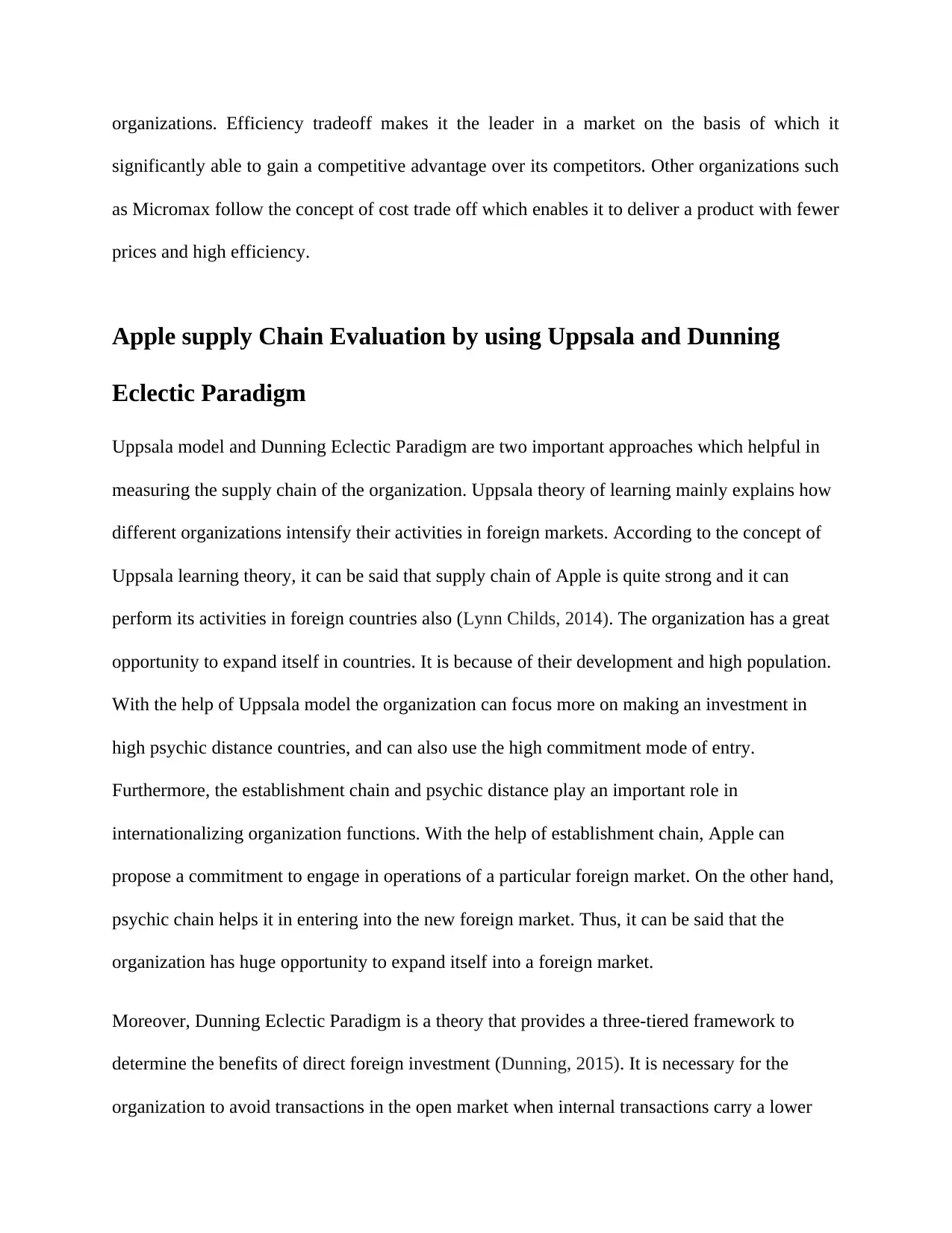
organizations. Efficiency tradeoff makes it the leader in a market on the basis of which it
significantly able to gain a competitive advantage over its competitors. Other organizations such
as Micromax follow the concept of cost trade off which enables it to deliver a product with fewer
prices and high efficiency.
Apple supply Chain Evaluation by using Uppsala and Dunning
Eclectic Paradigm
Uppsala model and Dunning Eclectic Paradigm are two important approaches which helpful in
measuring the supply chain of the organization. Uppsala theory of learning mainly explains how
different organizations intensify their activities in foreign markets. According to the concept of
Uppsala learning theory, it can be said that supply chain of Apple is quite strong and it can
perform its activities in foreign countries also (Lynn Childs, 2014). The organization has a great
opportunity to expand itself in countries. It is because of their development and high population.
With the help of Uppsala model the organization can focus more on making an investment in
high psychic distance countries, and can also use the high commitment mode of entry.
Furthermore, the establishment chain and psychic distance play an important role in
internationalizing organization functions. With the help of establishment chain, Apple can
propose a commitment to engage in operations of a particular foreign market. On the other hand,
psychic chain helps it in entering into the new foreign market. Thus, it can be said that the
organization has huge opportunity to expand itself into a foreign market.
Moreover, Dunning Eclectic Paradigm is a theory that provides a three-tiered framework to
determine the benefits of direct foreign investment (Dunning, 2015). It is necessary for the
organization to avoid transactions in the open market when internal transactions carry a lower
significantly able to gain a competitive advantage over its competitors. Other organizations such
as Micromax follow the concept of cost trade off which enables it to deliver a product with fewer
prices and high efficiency.
Apple supply Chain Evaluation by using Uppsala and Dunning
Eclectic Paradigm
Uppsala model and Dunning Eclectic Paradigm are two important approaches which helpful in
measuring the supply chain of the organization. Uppsala theory of learning mainly explains how
different organizations intensify their activities in foreign markets. According to the concept of
Uppsala learning theory, it can be said that supply chain of Apple is quite strong and it can
perform its activities in foreign countries also (Lynn Childs, 2014). The organization has a great
opportunity to expand itself in countries. It is because of their development and high population.
With the help of Uppsala model the organization can focus more on making an investment in
high psychic distance countries, and can also use the high commitment mode of entry.
Furthermore, the establishment chain and psychic distance play an important role in
internationalizing organization functions. With the help of establishment chain, Apple can
propose a commitment to engage in operations of a particular foreign market. On the other hand,
psychic chain helps it in entering into the new foreign market. Thus, it can be said that the
organization has huge opportunity to expand itself into a foreign market.
Moreover, Dunning Eclectic Paradigm is a theory that provides a three-tiered framework to
determine the benefits of direct foreign investment (Dunning, 2015). It is necessary for the
organization to avoid transactions in the open market when internal transactions carry a lower
Paraphrase This Document
Need a fresh take? Get an instant paraphrase of this document with our AI Paraphraser
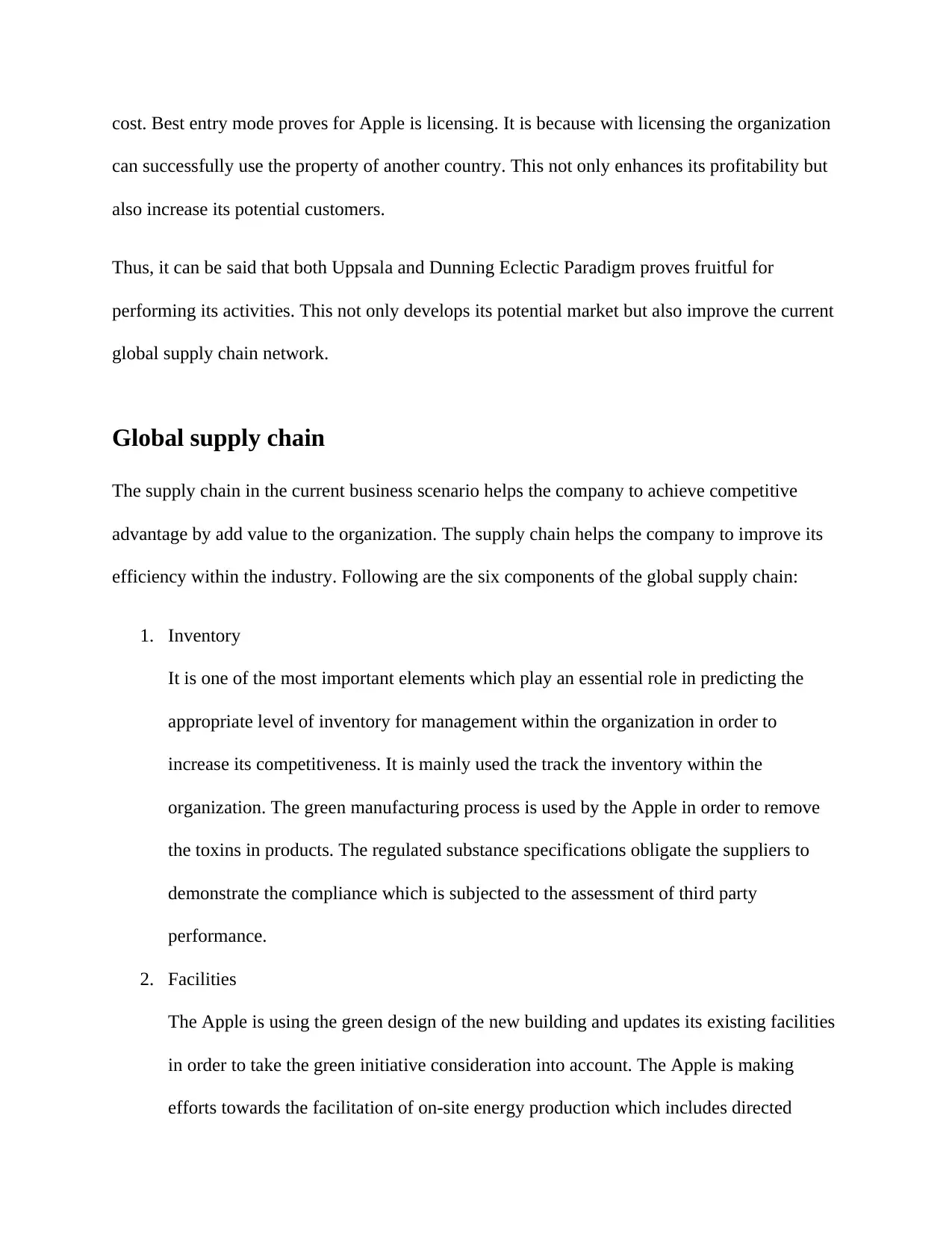
cost. Best entry mode proves for Apple is licensing. It is because with licensing the organization
can successfully use the property of another country. This not only enhances its profitability but
also increase its potential customers.
Thus, it can be said that both Uppsala and Dunning Eclectic Paradigm proves fruitful for
performing its activities. This not only develops its potential market but also improve the current
global supply chain network.
Global supply chain
The supply chain in the current business scenario helps the company to achieve competitive
advantage by add value to the organization. The supply chain helps the company to improve its
efficiency within the industry. Following are the six components of the global supply chain:
1. Inventory
It is one of the most important elements which play an essential role in predicting the
appropriate level of inventory for management within the organization in order to
increase its competitiveness. It is mainly used the track the inventory within the
organization. The green manufacturing process is used by the Apple in order to remove
the toxins in products. The regulated substance specifications obligate the suppliers to
demonstrate the compliance which is subjected to the assessment of third party
performance.
2. Facilities
The Apple is using the green design of the new building and updates its existing facilities
in order to take the green initiative consideration into account. The Apple is making
efforts towards the facilitation of on-site energy production which includes directed
can successfully use the property of another country. This not only enhances its profitability but
also increase its potential customers.
Thus, it can be said that both Uppsala and Dunning Eclectic Paradigm proves fruitful for
performing its activities. This not only develops its potential market but also improve the current
global supply chain network.
Global supply chain
The supply chain in the current business scenario helps the company to achieve competitive
advantage by add value to the organization. The supply chain helps the company to improve its
efficiency within the industry. Following are the six components of the global supply chain:
1. Inventory
It is one of the most important elements which play an essential role in predicting the
appropriate level of inventory for management within the organization in order to
increase its competitiveness. It is mainly used the track the inventory within the
organization. The green manufacturing process is used by the Apple in order to remove
the toxins in products. The regulated substance specifications obligate the suppliers to
demonstrate the compliance which is subjected to the assessment of third party
performance.
2. Facilities
The Apple is using the green design of the new building and updates its existing facilities
in order to take the green initiative consideration into account. The Apple is making
efforts towards the facilitation of on-site energy production which includes directed
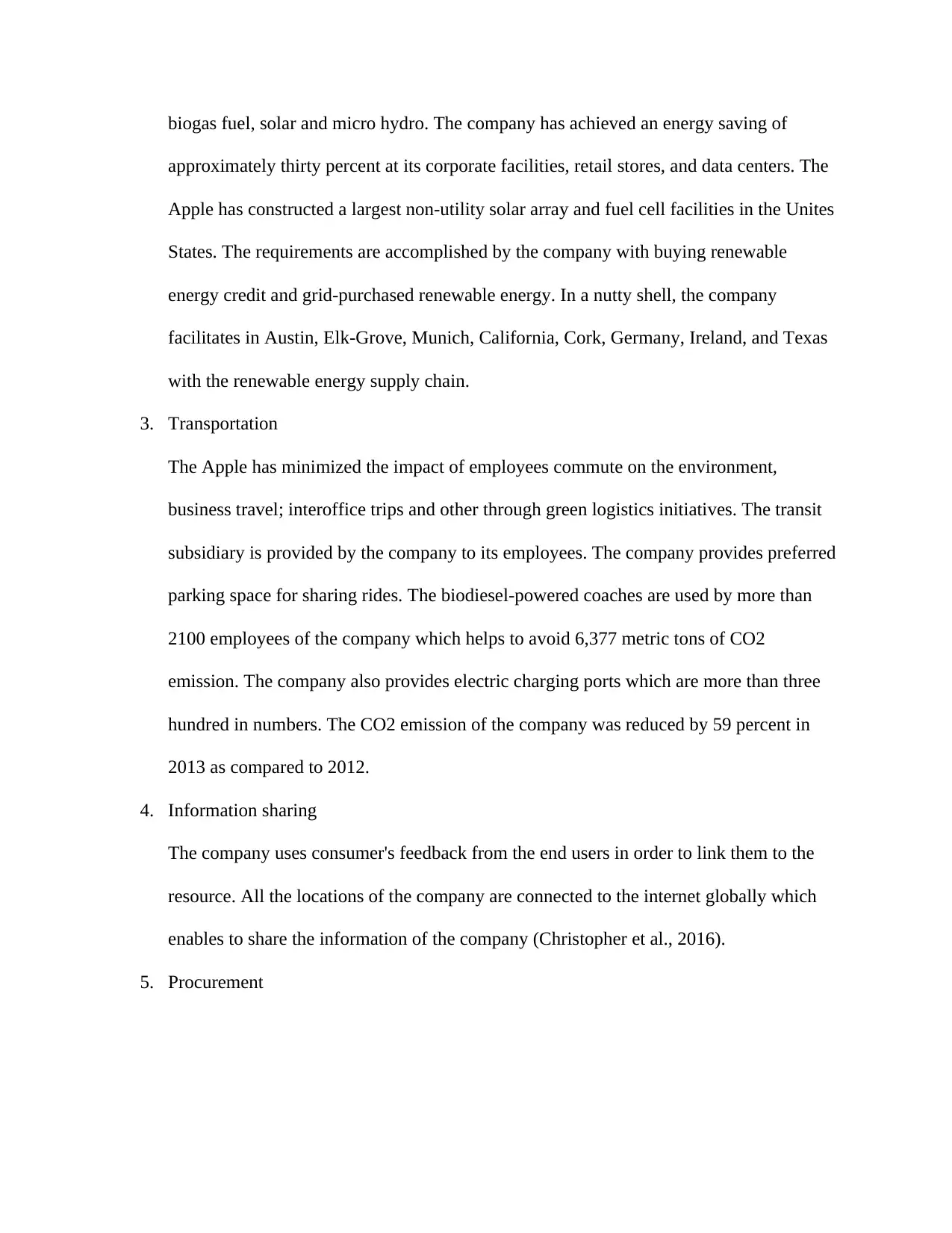
biogas fuel, solar and micro hydro. The company has achieved an energy saving of
approximately thirty percent at its corporate facilities, retail stores, and data centers. The
Apple has constructed a largest non-utility solar array and fuel cell facilities in the Unites
States. The requirements are accomplished by the company with buying renewable
energy credit and grid-purchased renewable energy. In a nutty shell, the company
facilitates in Austin, Elk-Grove, Munich, California, Cork, Germany, Ireland, and Texas
with the renewable energy supply chain.
3. Transportation
The Apple has minimized the impact of employees commute on the environment,
business travel; interoffice trips and other through green logistics initiatives. The transit
subsidiary is provided by the company to its employees. The company provides preferred
parking space for sharing rides. The biodiesel-powered coaches are used by more than
2100 employees of the company which helps to avoid 6,377 metric tons of CO2
emission. The company also provides electric charging ports which are more than three
hundred in numbers. The CO2 emission of the company was reduced by 59 percent in
2013 as compared to 2012.
4. Information sharing
The company uses consumer's feedback from the end users in order to link them to the
resource. All the locations of the company are connected to the internet globally which
enables to share the information of the company (Christopher et al., 2016).
5. Procurement
approximately thirty percent at its corporate facilities, retail stores, and data centers. The
Apple has constructed a largest non-utility solar array and fuel cell facilities in the Unites
States. The requirements are accomplished by the company with buying renewable
energy credit and grid-purchased renewable energy. In a nutty shell, the company
facilitates in Austin, Elk-Grove, Munich, California, Cork, Germany, Ireland, and Texas
with the renewable energy supply chain.
3. Transportation
The Apple has minimized the impact of employees commute on the environment,
business travel; interoffice trips and other through green logistics initiatives. The transit
subsidiary is provided by the company to its employees. The company provides preferred
parking space for sharing rides. The biodiesel-powered coaches are used by more than
2100 employees of the company which helps to avoid 6,377 metric tons of CO2
emission. The company also provides electric charging ports which are more than three
hundred in numbers. The CO2 emission of the company was reduced by 59 percent in
2013 as compared to 2012.
4. Information sharing
The company uses consumer's feedback from the end users in order to link them to the
resource. All the locations of the company are connected to the internet globally which
enables to share the information of the company (Christopher et al., 2016).
5. Procurement
⊘ This is a preview!⊘
Do you want full access?
Subscribe today to unlock all pages.

Trusted by 1+ million students worldwide
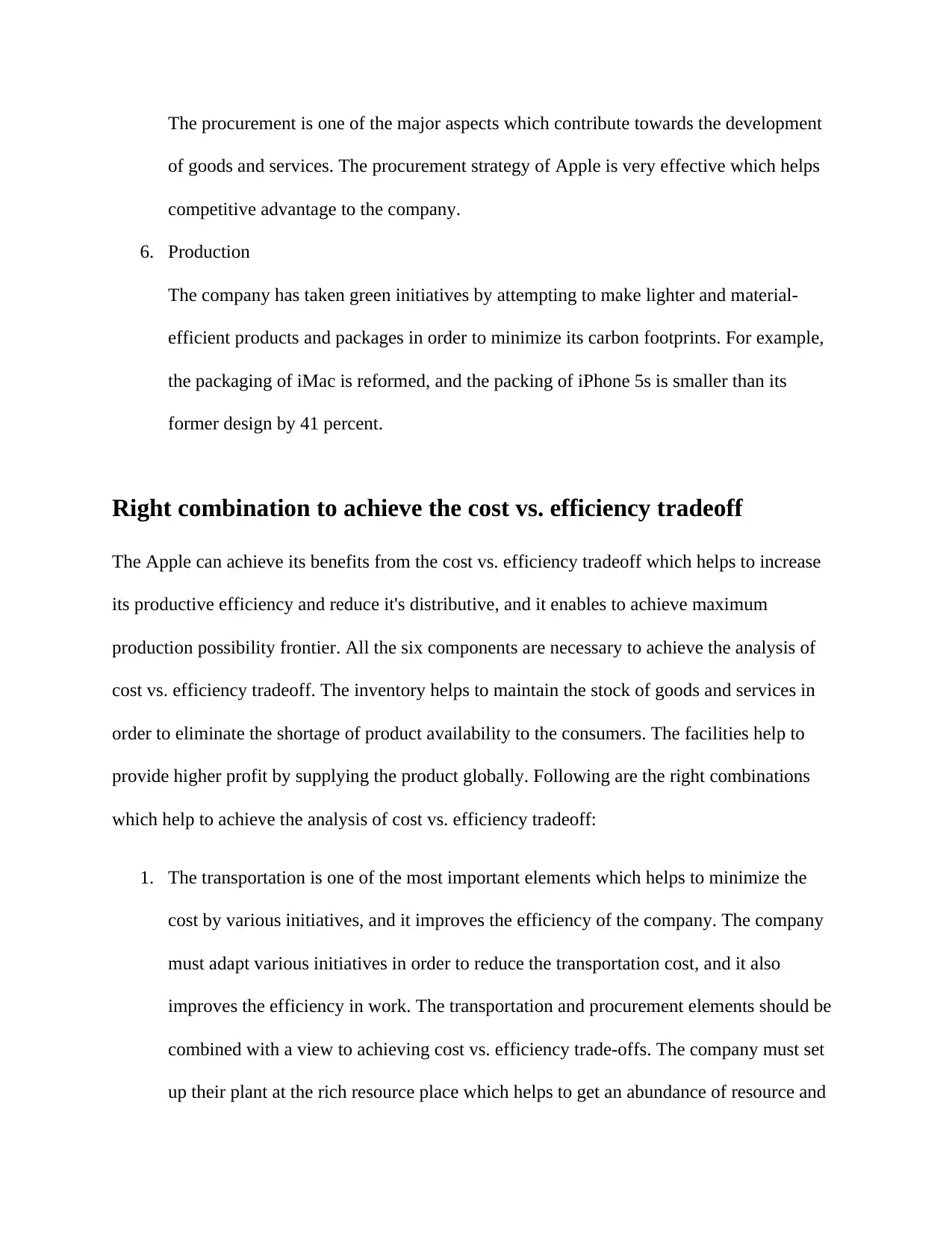
The procurement is one of the major aspects which contribute towards the development
of goods and services. The procurement strategy of Apple is very effective which helps
competitive advantage to the company.
6. Production
The company has taken green initiatives by attempting to make lighter and material-
efficient products and packages in order to minimize its carbon footprints. For example,
the packaging of iMac is reformed, and the packing of iPhone 5s is smaller than its
former design by 41 percent.
Right combination to achieve the cost vs. efficiency tradeoff
The Apple can achieve its benefits from the cost vs. efficiency tradeoff which helps to increase
its productive efficiency and reduce it's distributive, and it enables to achieve maximum
production possibility frontier. All the six components are necessary to achieve the analysis of
cost vs. efficiency tradeoff. The inventory helps to maintain the stock of goods and services in
order to eliminate the shortage of product availability to the consumers. The facilities help to
provide higher profit by supplying the product globally. Following are the right combinations
which help to achieve the analysis of cost vs. efficiency tradeoff:
1. The transportation is one of the most important elements which helps to minimize the
cost by various initiatives, and it improves the efficiency of the company. The company
must adapt various initiatives in order to reduce the transportation cost, and it also
improves the efficiency in work. The transportation and procurement elements should be
combined with a view to achieving cost vs. efficiency trade-offs. The company must set
up their plant at the rich resource place which helps to get an abundance of resource and
of goods and services. The procurement strategy of Apple is very effective which helps
competitive advantage to the company.
6. Production
The company has taken green initiatives by attempting to make lighter and material-
efficient products and packages in order to minimize its carbon footprints. For example,
the packaging of iMac is reformed, and the packing of iPhone 5s is smaller than its
former design by 41 percent.
Right combination to achieve the cost vs. efficiency tradeoff
The Apple can achieve its benefits from the cost vs. efficiency tradeoff which helps to increase
its productive efficiency and reduce it's distributive, and it enables to achieve maximum
production possibility frontier. All the six components are necessary to achieve the analysis of
cost vs. efficiency tradeoff. The inventory helps to maintain the stock of goods and services in
order to eliminate the shortage of product availability to the consumers. The facilities help to
provide higher profit by supplying the product globally. Following are the right combinations
which help to achieve the analysis of cost vs. efficiency tradeoff:
1. The transportation is one of the most important elements which helps to minimize the
cost by various initiatives, and it improves the efficiency of the company. The company
must adapt various initiatives in order to reduce the transportation cost, and it also
improves the efficiency in work. The transportation and procurement elements should be
combined with a view to achieving cost vs. efficiency trade-offs. The company must set
up their plant at the rich resource place which helps to get an abundance of resource and
Paraphrase This Document
Need a fresh take? Get an instant paraphrase of this document with our AI Paraphraser
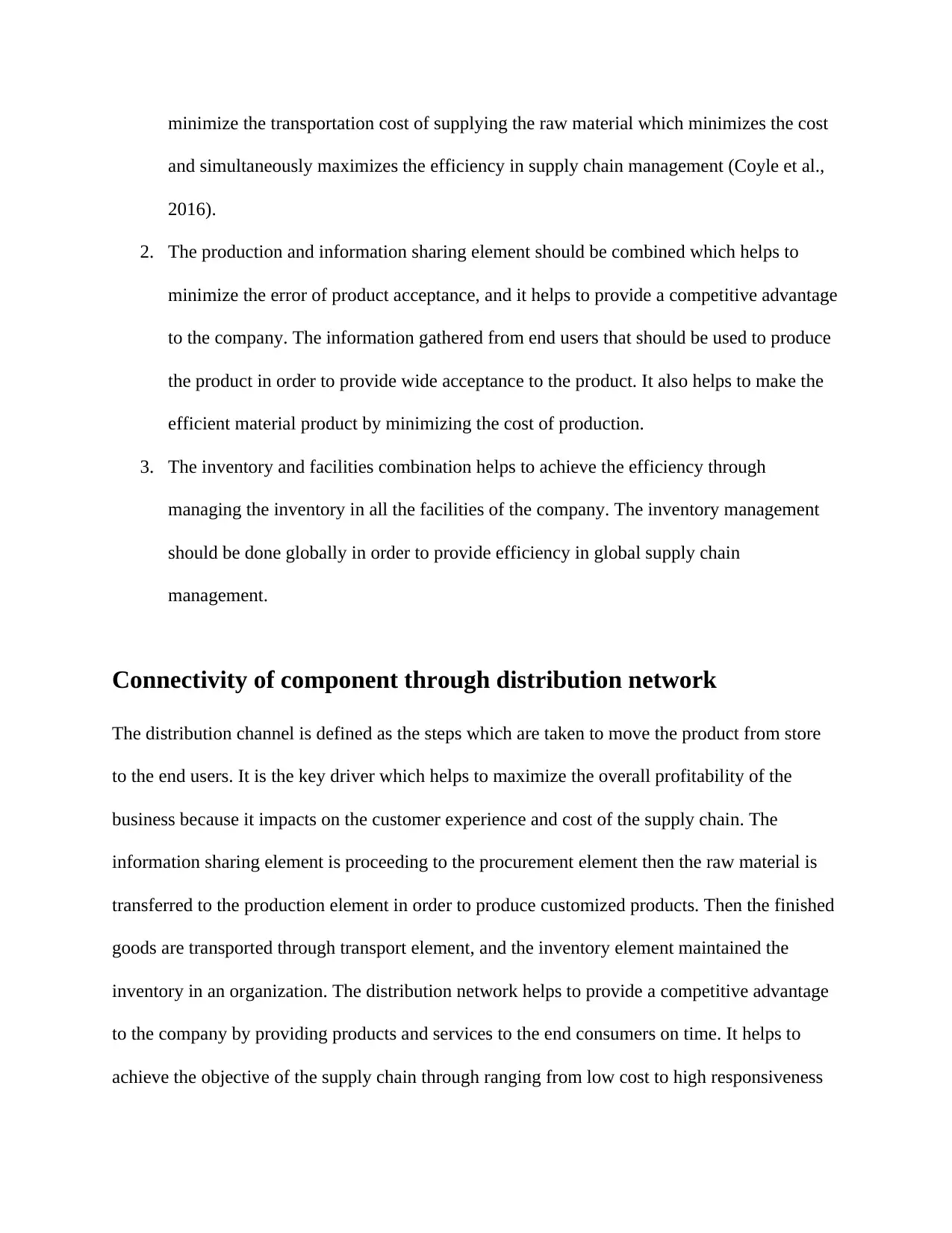
minimize the transportation cost of supplying the raw material which minimizes the cost
and simultaneously maximizes the efficiency in supply chain management (Coyle et al.,
2016).
2. The production and information sharing element should be combined which helps to
minimize the error of product acceptance, and it helps to provide a competitive advantage
to the company. The information gathered from end users that should be used to produce
the product in order to provide wide acceptance to the product. It also helps to make the
efficient material product by minimizing the cost of production.
3. The inventory and facilities combination helps to achieve the efficiency through
managing the inventory in all the facilities of the company. The inventory management
should be done globally in order to provide efficiency in global supply chain
management.
Connectivity of component through distribution network
The distribution channel is defined as the steps which are taken to move the product from store
to the end users. It is the key driver which helps to maximize the overall profitability of the
business because it impacts on the customer experience and cost of the supply chain. The
information sharing element is proceeding to the procurement element then the raw material is
transferred to the production element in order to produce customized products. Then the finished
goods are transported through transport element, and the inventory element maintained the
inventory in an organization. The distribution network helps to provide a competitive advantage
to the company by providing products and services to the end consumers on time. It helps to
achieve the objective of the supply chain through ranging from low cost to high responsiveness
and simultaneously maximizes the efficiency in supply chain management (Coyle et al.,
2016).
2. The production and information sharing element should be combined which helps to
minimize the error of product acceptance, and it helps to provide a competitive advantage
to the company. The information gathered from end users that should be used to produce
the product in order to provide wide acceptance to the product. It also helps to make the
efficient material product by minimizing the cost of production.
3. The inventory and facilities combination helps to achieve the efficiency through
managing the inventory in all the facilities of the company. The inventory management
should be done globally in order to provide efficiency in global supply chain
management.
Connectivity of component through distribution network
The distribution channel is defined as the steps which are taken to move the product from store
to the end users. It is the key driver which helps to maximize the overall profitability of the
business because it impacts on the customer experience and cost of the supply chain. The
information sharing element is proceeding to the procurement element then the raw material is
transferred to the production element in order to produce customized products. Then the finished
goods are transported through transport element, and the inventory element maintained the
inventory in an organization. The distribution network helps to provide a competitive advantage
to the company by providing products and services to the end consumers on time. It helps to
achieve the objective of the supply chain through ranging from low cost to high responsiveness
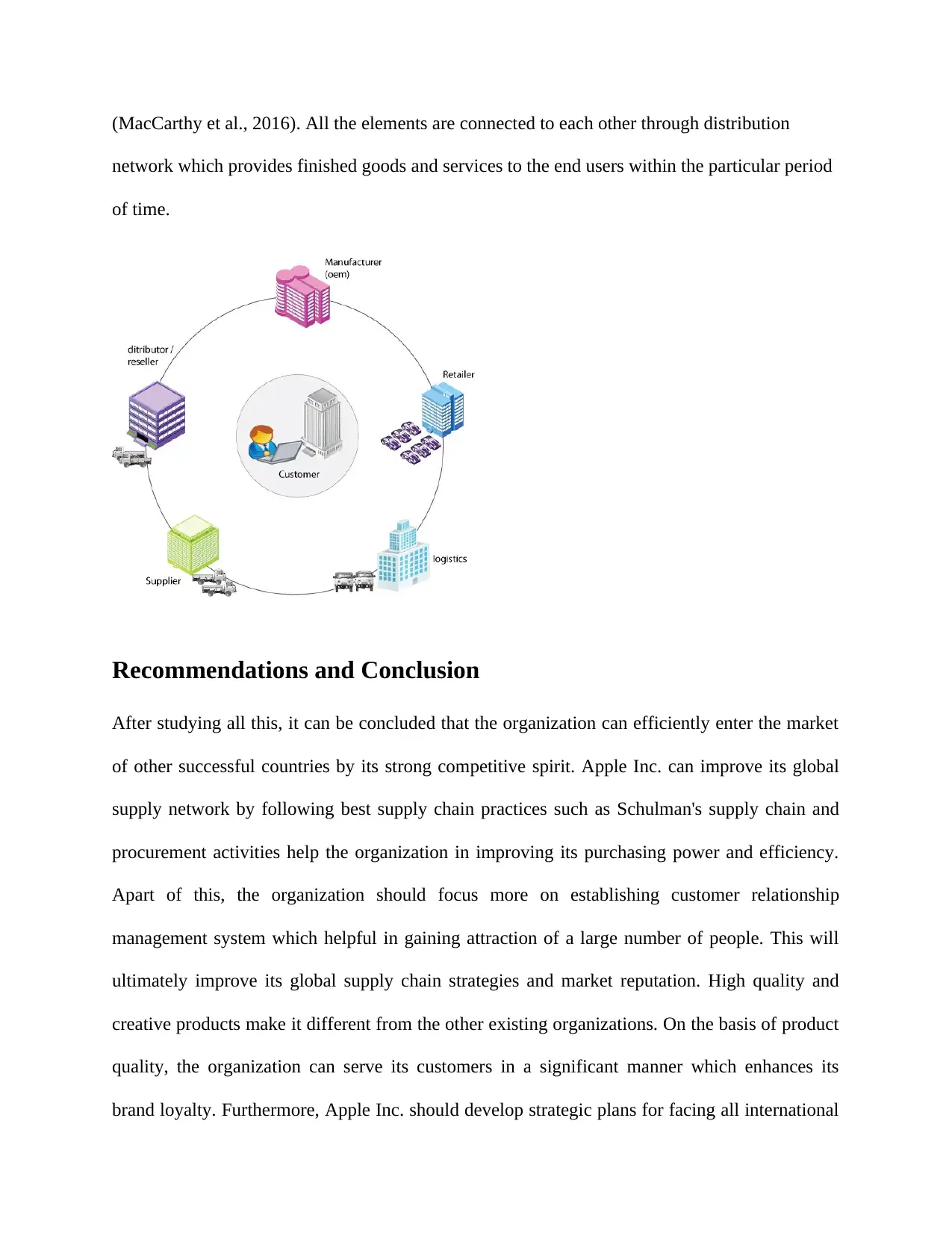
(MacCarthy et al., 2016). All the elements are connected to each other through distribution
network which provides finished goods and services to the end users within the particular period
of time.
Recommendations and Conclusion
After studying all this, it can be concluded that the organization can efficiently enter the market
of other successful countries by its strong competitive spirit. Apple Inc. can improve its global
supply network by following best supply chain practices such as Schulman's supply chain and
procurement activities help the organization in improving its purchasing power and efficiency.
Apart of this, the organization should focus more on establishing customer relationship
management system which helpful in gaining attraction of a large number of people. This will
ultimately improve its global supply chain strategies and market reputation. High quality and
creative products make it different from the other existing organizations. On the basis of product
quality, the organization can serve its customers in a significant manner which enhances its
brand loyalty. Furthermore, Apple Inc. should develop strategic plans for facing all international
network which provides finished goods and services to the end users within the particular period
of time.
Recommendations and Conclusion
After studying all this, it can be concluded that the organization can efficiently enter the market
of other successful countries by its strong competitive spirit. Apple Inc. can improve its global
supply network by following best supply chain practices such as Schulman's supply chain and
procurement activities help the organization in improving its purchasing power and efficiency.
Apart of this, the organization should focus more on establishing customer relationship
management system which helpful in gaining attraction of a large number of people. This will
ultimately improve its global supply chain strategies and market reputation. High quality and
creative products make it different from the other existing organizations. On the basis of product
quality, the organization can serve its customers in a significant manner which enhances its
brand loyalty. Furthermore, Apple Inc. should develop strategic plans for facing all international
⊘ This is a preview!⊘
Do you want full access?
Subscribe today to unlock all pages.

Trusted by 1+ million students worldwide
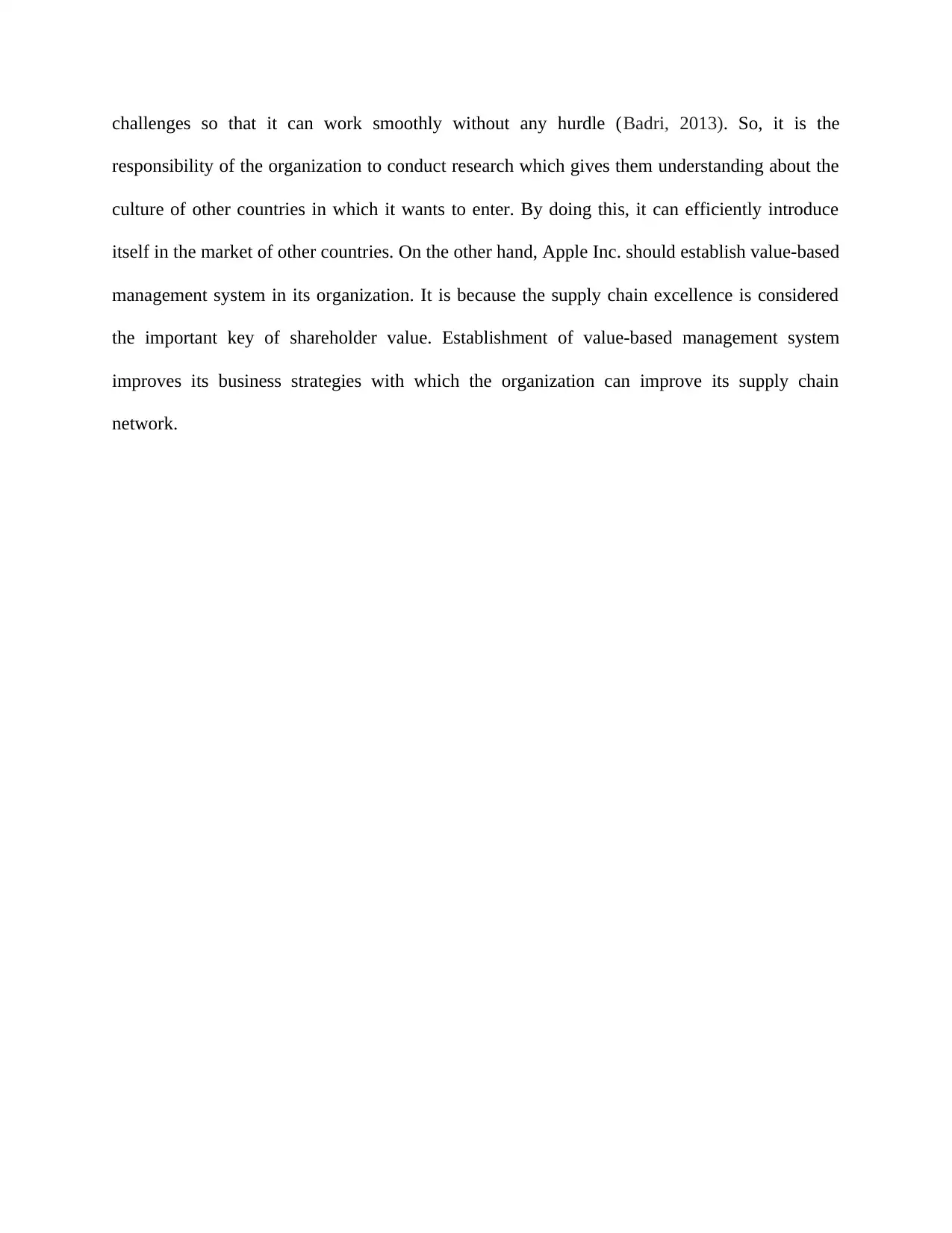
challenges so that it can work smoothly without any hurdle (Badri, 2013). So, it is the
responsibility of the organization to conduct research which gives them understanding about the
culture of other countries in which it wants to enter. By doing this, it can efficiently introduce
itself in the market of other countries. On the other hand, Apple Inc. should establish value-based
management system in its organization. It is because the supply chain excellence is considered
the important key of shareholder value. Establishment of value-based management system
improves its business strategies with which the organization can improve its supply chain
network.
responsibility of the organization to conduct research which gives them understanding about the
culture of other countries in which it wants to enter. By doing this, it can efficiently introduce
itself in the market of other countries. On the other hand, Apple Inc. should establish value-based
management system in its organization. It is because the supply chain excellence is considered
the important key of shareholder value. Establishment of value-based management system
improves its business strategies with which the organization can improve its supply chain
network.
Paraphrase This Document
Need a fresh take? Get an instant paraphrase of this document with our AI Paraphraser
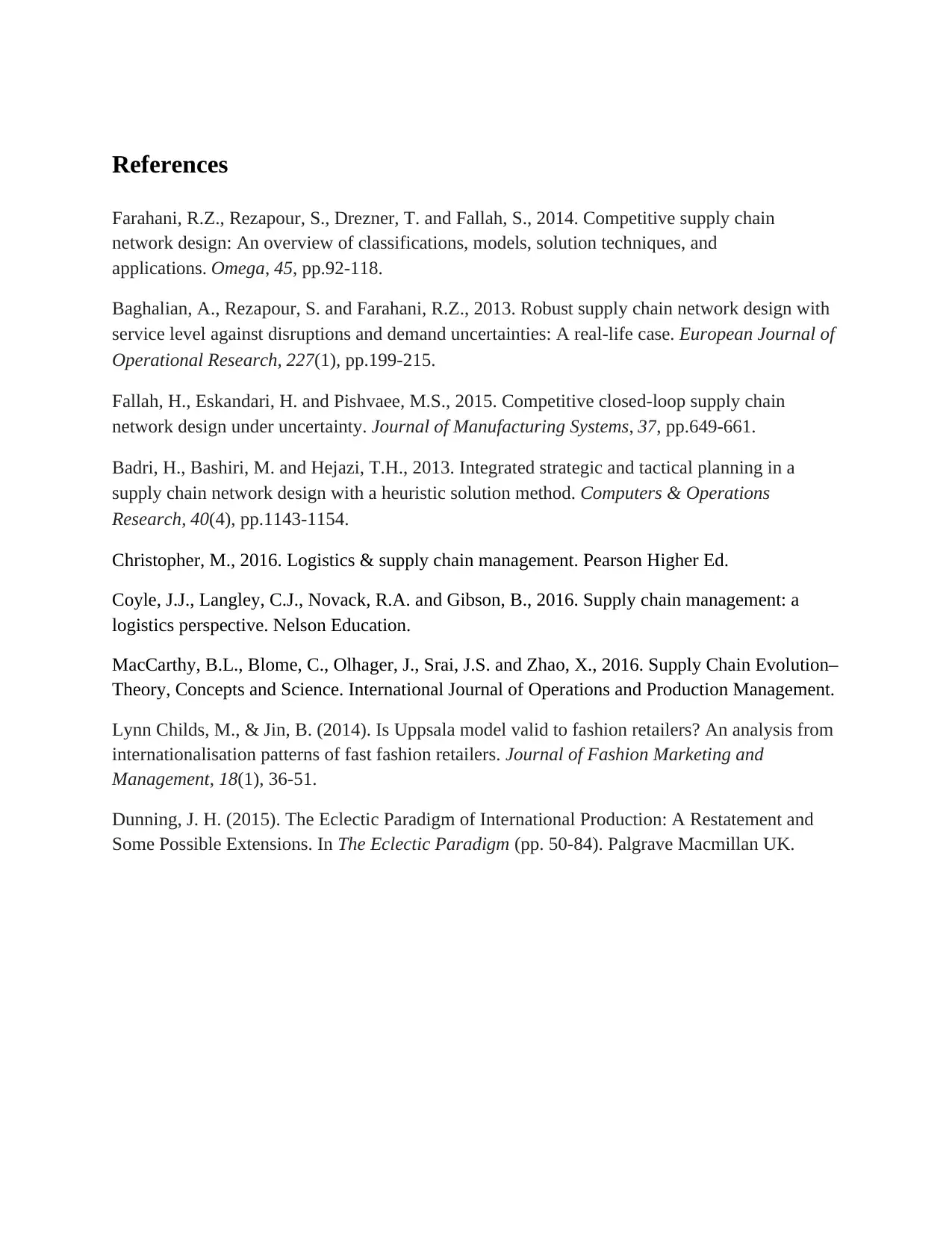
References
Farahani, R.Z., Rezapour, S., Drezner, T. and Fallah, S., 2014. Competitive supply chain
network design: An overview of classifications, models, solution techniques, and
applications. Omega, 45, pp.92-118.
Baghalian, A., Rezapour, S. and Farahani, R.Z., 2013. Robust supply chain network design with
service level against disruptions and demand uncertainties: A real-life case. European Journal of
Operational Research, 227(1), pp.199-215.
Fallah, H., Eskandari, H. and Pishvaee, M.S., 2015. Competitive closed-loop supply chain
network design under uncertainty. Journal of Manufacturing Systems, 37, pp.649-661.
Badri, H., Bashiri, M. and Hejazi, T.H., 2013. Integrated strategic and tactical planning in a
supply chain network design with a heuristic solution method. Computers & Operations
Research, 40(4), pp.1143-1154.
Christopher, M., 2016. Logistics & supply chain management. Pearson Higher Ed.
Coyle, J.J., Langley, C.J., Novack, R.A. and Gibson, B., 2016. Supply chain management: a
logistics perspective. Nelson Education.
MacCarthy, B.L., Blome, C., Olhager, J., Srai, J.S. and Zhao, X., 2016. Supply Chain Evolution–
Theory, Concepts and Science. International Journal of Operations and Production Management.
Lynn Childs, M., & Jin, B. (2014). Is Uppsala model valid to fashion retailers? An analysis from
internationalisation patterns of fast fashion retailers. Journal of Fashion Marketing and
Management, 18(1), 36-51.
Dunning, J. H. (2015). The Eclectic Paradigm of International Production: A Restatement and
Some Possible Extensions. In The Eclectic Paradigm (pp. 50-84). Palgrave Macmillan UK.
Farahani, R.Z., Rezapour, S., Drezner, T. and Fallah, S., 2014. Competitive supply chain
network design: An overview of classifications, models, solution techniques, and
applications. Omega, 45, pp.92-118.
Baghalian, A., Rezapour, S. and Farahani, R.Z., 2013. Robust supply chain network design with
service level against disruptions and demand uncertainties: A real-life case. European Journal of
Operational Research, 227(1), pp.199-215.
Fallah, H., Eskandari, H. and Pishvaee, M.S., 2015. Competitive closed-loop supply chain
network design under uncertainty. Journal of Manufacturing Systems, 37, pp.649-661.
Badri, H., Bashiri, M. and Hejazi, T.H., 2013. Integrated strategic and tactical planning in a
supply chain network design with a heuristic solution method. Computers & Operations
Research, 40(4), pp.1143-1154.
Christopher, M., 2016. Logistics & supply chain management. Pearson Higher Ed.
Coyle, J.J., Langley, C.J., Novack, R.A. and Gibson, B., 2016. Supply chain management: a
logistics perspective. Nelson Education.
MacCarthy, B.L., Blome, C., Olhager, J., Srai, J.S. and Zhao, X., 2016. Supply Chain Evolution–
Theory, Concepts and Science. International Journal of Operations and Production Management.
Lynn Childs, M., & Jin, B. (2014). Is Uppsala model valid to fashion retailers? An analysis from
internationalisation patterns of fast fashion retailers. Journal of Fashion Marketing and
Management, 18(1), 36-51.
Dunning, J. H. (2015). The Eclectic Paradigm of International Production: A Restatement and
Some Possible Extensions. In The Eclectic Paradigm (pp. 50-84). Palgrave Macmillan UK.
1 out of 11
Related Documents
Your All-in-One AI-Powered Toolkit for Academic Success.
+13062052269
info@desklib.com
Available 24*7 on WhatsApp / Email
![[object Object]](/_next/static/media/star-bottom.7253800d.svg)
Unlock your academic potential
Copyright © 2020–2025 A2Z Services. All Rights Reserved. Developed and managed by ZUCOL.





